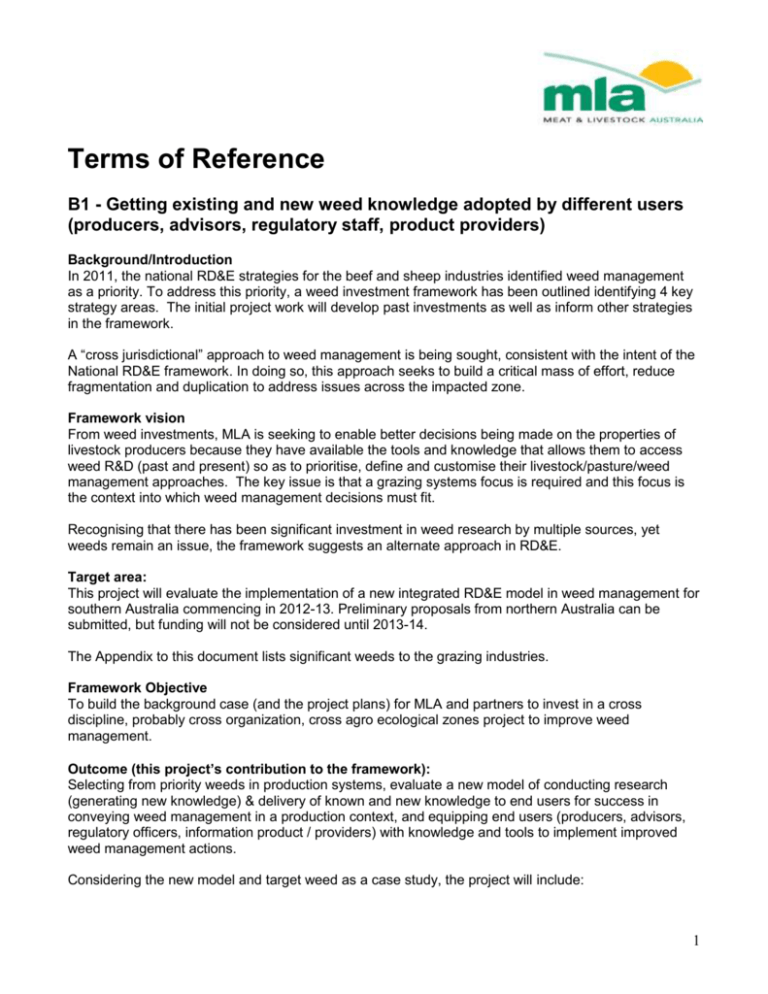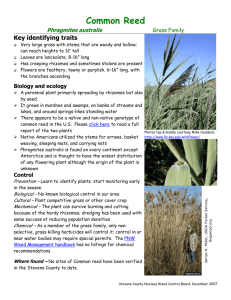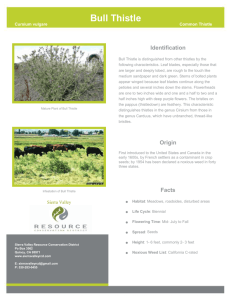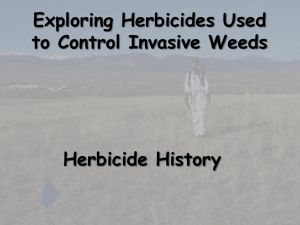Getting existing and new weed knowledge adopted by different users
advertisement

Terms of Reference B1 - Getting existing and new weed knowledge adopted by different users (producers, advisors, regulatory staff, product providers) Background/Introduction In 2011, the national RD&E strategies for the beef and sheep industries identified weed management as a priority. To address this priority, a weed investment framework has been outlined identifying 4 key strategy areas. The initial project work will develop past investments as well as inform other strategies in the framework. A “cross jurisdictional” approach to weed management is being sought, consistent with the intent of the National RD&E framework. In doing so, this approach seeks to build a critical mass of effort, reduce fragmentation and duplication to address issues across the impacted zone. Framework vision From weed investments, MLA is seeking to enable better decisions being made on the properties of livestock producers because they have available the tools and knowledge that allows them to access weed R&D (past and present) so as to prioritise, define and customise their livestock/pasture/weed management approaches. The key issue is that a grazing systems focus is required and this focus is the context into which weed management decisions must fit. Recognising that there has been significant investment in weed research by multiple sources, yet weeds remain an issue, the framework suggests an alternate approach in RD&E. Target area: This project will evaluate the implementation of a new integrated RD&E model in weed management for southern Australia commencing in 2012-13. Preliminary proposals from northern Australia can be submitted, but funding will not be considered until 2013-14. The Appendix to this document lists significant weeds to the grazing industries. Framework Objective To build the background case (and the project plans) for MLA and partners to invest in a cross discipline, probably cross organization, cross agro ecological zones project to improve weed management. Outcome (this project’s contribution to the framework): Selecting from priority weeds in production systems, evaluate a new model of conducting research (generating new knowledge) & delivery of known and new knowledge to end users for success in conveying weed management in a production context, and equipping end users (producers, advisors, regulatory officers, information product / providers) with knowledge and tools to implement improved weed management actions. Considering the new model and target weed as a case study, the project will include: 1 a “knowledge base line” of end users in the project; defining end user need for weed information / tools for the targeted weed; gaps in available knowledge (to adderss those needs) identifying motivations, decision drivers, knowledge gaps (and so inform research); determining “information packaging” mechanisms to meet end user needs; success in adoption of information new knowledge – “system implications” impacting on success Please note, the project is not a consultancy to scope a new delivery process, but based on the prior investment, publications and experience: propose and implement a recommended process that primarily aims to increase use of the research output by end users, engages many more producers in implementation of recommended practices engages these producers and end users contributing to research (eg understanding factors impacting on success) based on a recommended practice the project will generate and test a process for additional information generation, greater participation of end users, communication / networking, product development to enable the compelling case that meets the needs (for use / adoption) of producers, advisors, regulatory officers and product providers. Project activity: i) Selecting from weeds that are significant to the livestock industries, develop a preliminary 3 year research project to evaluate an improved integrated research and extension process that includes active participation by end users implementing current recommended practice, partnerships (researcher/ advisors/ regulatory/ agribusiness), “communities of interest” (dealing with weeds in a landscape context) and: utilises “local knowledge” and information sharing from producers and others improves each stakeholder’s decision making and basis for interacting to improve weed management outcomes provides evidence of change in knowledge / practice by end users undertakes research (eg on system, spatial / temporal aspects) in weed management informs the “community of interest” by receiving information from new research and the “community of interest” on processes / successes / failures of other end users ii) The project should: aim to be conducted across a significant portion of the infestation area involve associated end user / organisations in implementation maximise the numbers of producers who implement the recommended process, and engage in a participatory research process. Feedback / data from these producer activities informs research exploring system (contextual) and spatial implications of the recommended practices (and so improves the recommendations) maximise engagement of project team partners, organisations with interest in improved weed management (eg regional nrm bodies, regulatory staff, local council, research providers, agribusiness, advisors), for a critical mass of effort and consistent message. iii) Establish from end users, base-line information (biophysical, attitudinal, what influences decisions), that will inform improved delivery, and support evaluation of the new model: Knowledge base of producers, researchers, extension staff, regulatory officers inventory of weed presence and impact (on farm and region) 2 management options deployed information sources on weed management in pastures suitability of information / tools, for success in control Document usefulness / non-usefulness of existing programs / processes what underpinned successes in weed management ? what info / tools/ processes are required for a “better result” ? Determine the ‘needs’ of the end user to make a compelling case what decisions are required in livestock production and land management? what weed related decisions are required ? what information is needed for management decisions? who should be involved in their weed program, with independent decision making pressures (regulation/ neighbours/ council etc)? iv) Define weed management research questions, and packaging recommendations of research output from identifying the ‘gaps’ in what is known / delivered and what is needed v) Evaluate the project covering: success in conveying weed management in a production context, utilisation and change of practice by the end user new knowledge generated for the target weeds change in participant’s behaviour / approach with weed management (eg has the project addressed suggested issue areas in (iii) ?) vi) Make recommendations to improve the research and extension strategy implemented Budget: $300,000 pa to be allocated among approved projects Response to this term of reference: Preliminary project proposals should be submitted on the embedded template and are required to be lodged via email to applications@mla.com.au by close of business on 15 February, 2013. NOTE The subject line should be labelled “Weed B1- and your organisation’s name”. Please ensure the preliminary proposal is labelled “B1- and your organisation’s name”. Preliminary-applicatio nWeeds 2012.doc Further Information Cameron Allan callan@mla.com.au 02 6361 1204 3 Appendix 1 Significant weeds to the grazing industries 1) Priority listing derived by Grice (2003) requiring research. The report lists other priority species where research areas may all be rated as “Low”, but by implication indicates a gap in delivery / adoption. Extract from Grice.docx Species parkinsonia lantana bellyache bush mesquites creeping lantana tobacco weed mother-of-millions rat’s tail grasses chillean needle grass african lovegrass lippia silverleaf nightshade prairie ground cherry Ecology H H H M H H H H H H H H H Biocontrol H M H H H H H M L H H H Management H H H H H H H H H H H H H 4 2) Emerging weeds. At least some of these are on the way to becoming or have the potential to become highly significant for grazing industries. Some are already a problem over portions of their potential ranges (derived from Grice 2003 and other sources) Common name Scientific name spotted knapweed black knapweed Hawkweeds bahia grass cape tulip chilean needle grass chinese celtis fountain grass green cestrum lippia mother-of-millions Neem perennial mission grass prairie ground cherry praxelis silverleaf nightshade sisal hemp tobacco weed yellow oleander = captain cook bush branched broomrape small-seeded dodder three-horned bedstraw Chincherinchee Lincoln weed rubber bush (Calotrope) parthenium prickly acacia rubber vine grader grass coffee senna Centaurea maculosa Centaurea nigra Hieracium spp. Paspalum notatum Homeria spp. Nassella trichotoma Celtis sinensis Pennisetum setaceum Cestrum parqui Phyla canescens Bryophyllum delagoense Azadirachta indica Pennisetum polystachion Physalis viscose Praxelis clematidea Solanum elaeagnifolium Agave sisalana Elephantopus mollis Thevetia peruviana = Cascabela peruviana Orobanche sp. Cuscuta planifolia Galium tricornutum Ornithogalum thyrsoides Diplotaxis tenuifolia 5 3) Economic ranking with combined economic, environmental and social impact data ranking (Thorpe 2011 revising 2000 estimates) Weeds of national significance Economic ranking EcoEnvirSoc ranking Common name EcoEnvirSoc (max. 3) 1 2 3 4 5 6 7 8 9 10 11 12 13 14 15 16 17 18 19 20 21 22 23 24 25 1 4 3 2 6 12 5 9 7 10 19 21 16 11 20 22 13 8 15 24 17 14 23 18 25 blackberry ragwort gorse Paterson's curse serrated tussock Sicklepod parthenium weed prickly acacia rubber vine mesquite onopordum thistles Silver leaf nightshade giant Parramatta grass lantana St John's wort giant rat's tail grass African boxthorn mimosa Bathurst burr§ Fireweed Parkinsonia Noogoora burr hyptis narrow leafed cotton bush bellyache bush 2.6668 1.7793 1.8912 2.0123 1.7288 1.0917 1.7411 1.2985 1.3769 1.2454 0.8033 0.6520 1.0031 1.2149 0.7994 0.5600 1.0886 1.3119 1.0107 0.4443 0.9662 1.0461 0.4870 0.8158 0.4438 score 6 4) The most commonly reported weeds (n=934 respondents in a survey across southern Australia, predominately the higher rainfall zone and cereal zone (coastal not included), Trotter 2008) Species Arctotheca calendula Echium plantagineum Hordeum spp. Carthamus lanatus Rubus fruticosus Onopordum spp. Xanthium spinosum Vulpia spp. Thistles (generic conglomeration) Marrubium vulgare Silybum marianum L. Rumex spp. (docks) Nassella trichotoma Hypericum perforatum Cirsium vulgare Raphanus raphanistrum Erodium spp. Pteridium esculentum Carduus pycnocephalus & tenuiflorus Rumex acetosella Rosa rubiginosa Citrullus spp. Carduus nutans Agrostis capillaris Emex australis Lolium rigidum Juncus spp. Heliotropium spp. Eragrostis curvula Holcus spp. Bromus spp. Ulex europaeus Cynodon dactylon Asphodelus fistulosus Avena spp. Geranium spp Polygonum aviculare Brassica rapa Solanum elaeagnifolium Tribulus terrestris Homeria spp. Common names Capeweed Paterson’s curse Barley grass Saffron thistle Blackberry Scotch thistle, Illyrian / Onopordum / Blue thistle Bathurst burr Silver grass, Rats tail fescue, Vulpia Thistles Horehound Variegated thistle, Cabbage thistle Dock, Curled dock Serrated tussock, Tussock, Yass river tussock St John’s wort Black thistle, Spear thistle, Scotch thistle Wild radish, charlock Erodium, Crows foot, Sorksbill, Corkscrew Bracken fern Slender thistle, Shore thistle Sorrel Sweet briar, Briar rose, Brisars Paddy/ / Camel / Afghan melon Nodding thistle Bent grass, brown top bent grass Cat head, three corner jack, spiny emex Annual ryegrass Rushs, Pin rush, Toad rush Heliotrope, Blue heliotrope African lovegrass Yorkshire fog, Fog grass Brome grass, Soft brome, Rip gut brome Gorse Couch grass Onion weed Wild oats Geranium Wireweed, hogweed Wild turnip Deadly nightshade Caltrop, Yellow vine Cape tulip 7 Chondrilla juncea Stipa spp. Romulea rosea Tussock grass Lycium ferocissimum Urtica spp. Centaurea calcitrapa Chenopodium album Taraxacum officinale Juncus acutus Cassinia spp. Nassella neesiana Alternanthera pungens Galinsoga parviflora Skeleton weed Spear grass Onion grass, Guildford grass Tussock grass African boxthorn, Boxthorn Stinging nettle Star thistle Fat hen Dandelion Spiny rush Dog wood, Sifton bush, Biddy bush Chilean needle grass, Needle grass Khaki weed Potato weed 8





